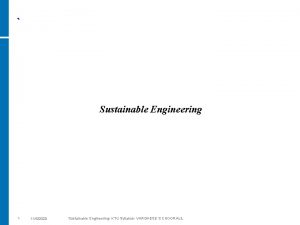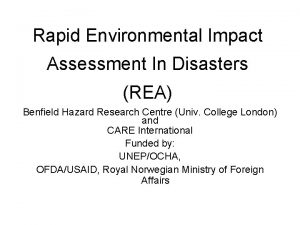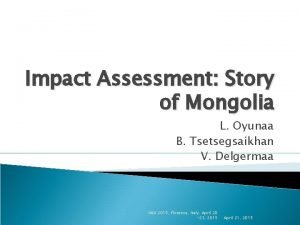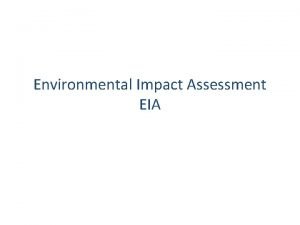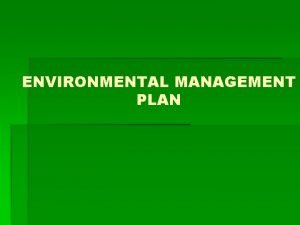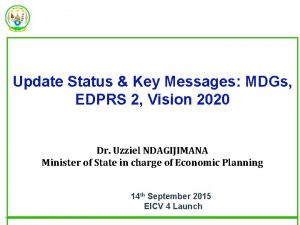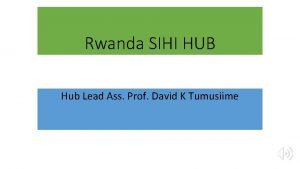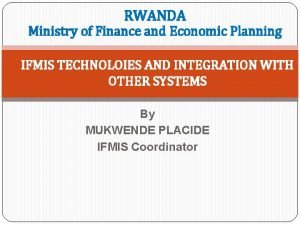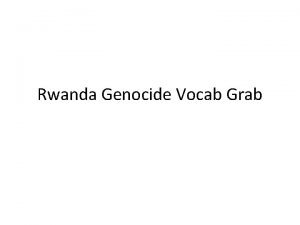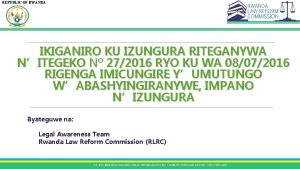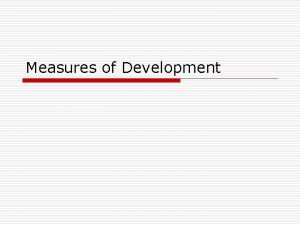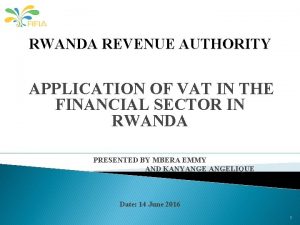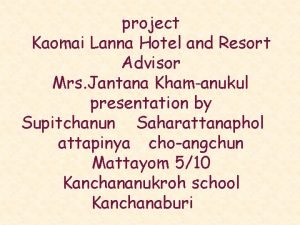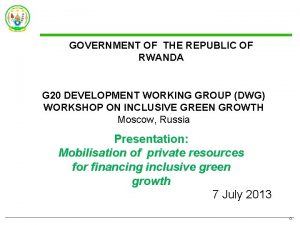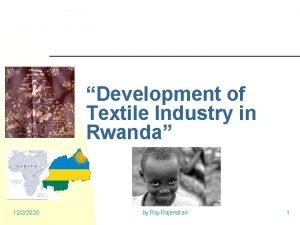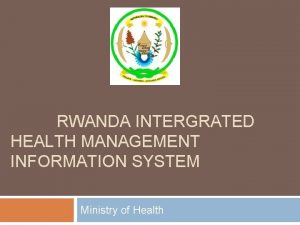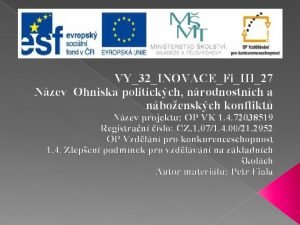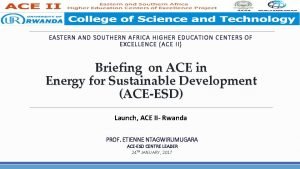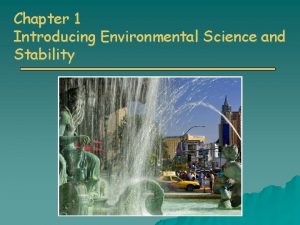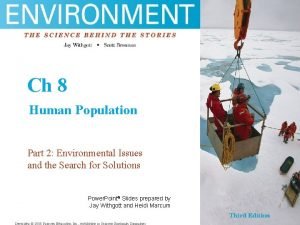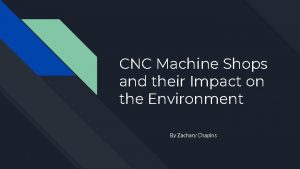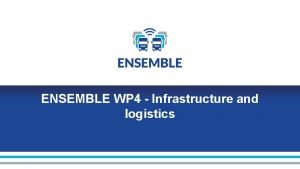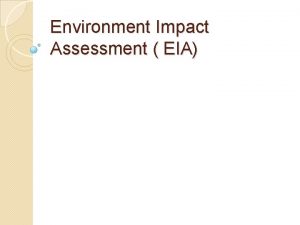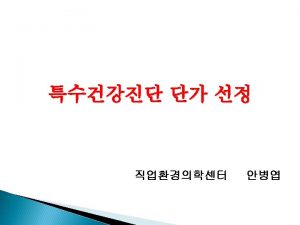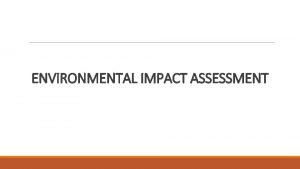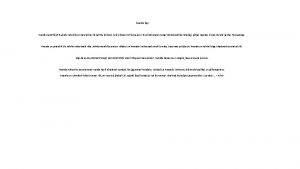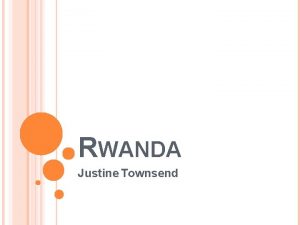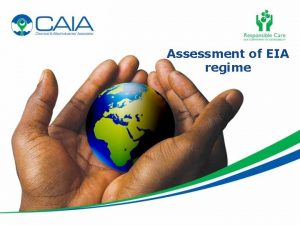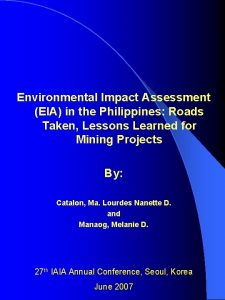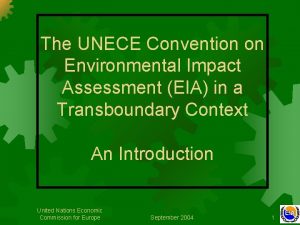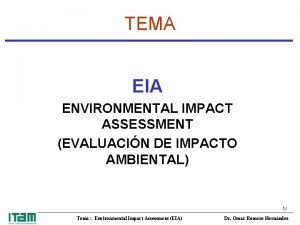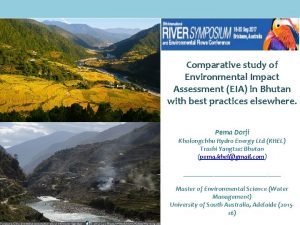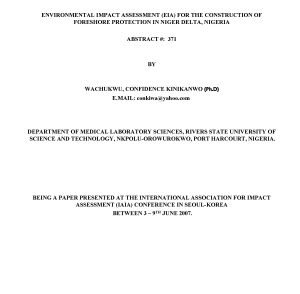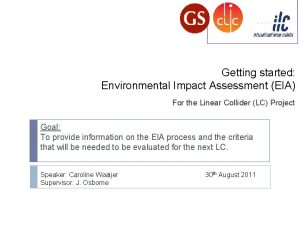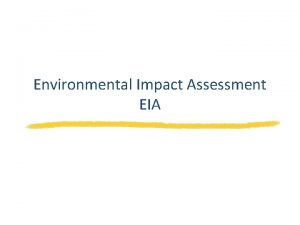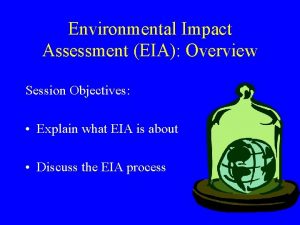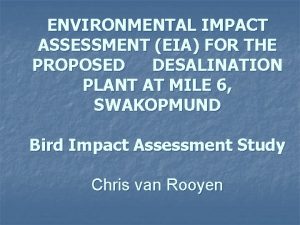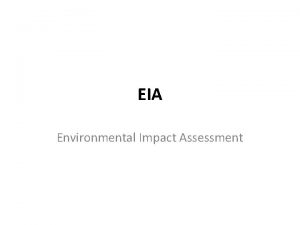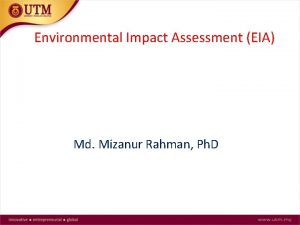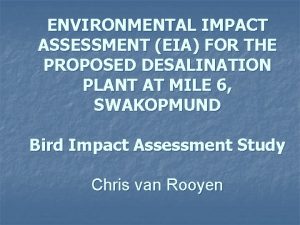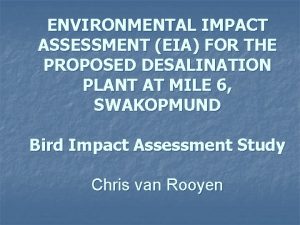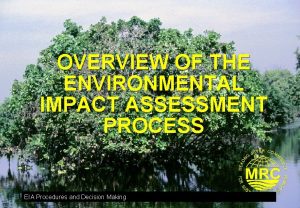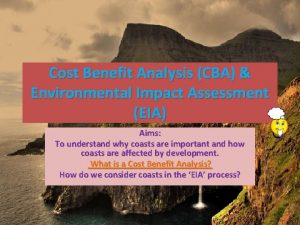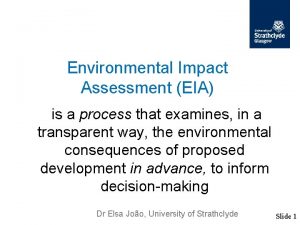ENVIRONMENTAL PLANNING IN RWANDA ENVIRONMENTAL IMPACT ASSESSMENT EIA


































- Slides: 34

ENVIRONMENTAL PLANNING IN : RWANDA ENVIRONMENTAL IMPACT ASSESSMENT (EIA) AS A PLANNING TOOL AND ITS EFFECTIVENESS Theobald MASHINGA Rwanda Environment Management Authority (REMA) Rwanda. IAIA 07, Seoul, Korea 3 rd -9 th , June 2007

Presentation Outline n n n F Definition of EIA; Historical Background and Context of EIA in Rwanda; Policy and Legal Framework on EIA; International Context of EIA; EIA Practice in Rwanda: EIA Process and Procedures in Rwanda

Presentation Outline (Cont…. . ) The EIA Process in Practice; F Challenges to operationalise EIA: 6 Screening; Scoping and Terms of Reference; Quality of the EIAs ; 6 Decision-making and appeals against decisions; Inadequate expertise F

Presentation Outline (Cont…. . ) Public Participation; Data Inadequacy; 6 Cost of Conducting EIA and Processing Fees; n Opportunities for Improving the EIA Process: F Publicizing and developing the EIA Legislation; Private Sector and Public Participation 6

Presentation Outline (Cont…. . ) F Environmental Management Plans and Audits; Strengthening Public Private Partnership; F Promoting and Developing Capacity Building; Strengthening Enforcement Mechanisms; n Conclusion

Definition of EIA n EIA is defined as a systematic process to identify, predict and evaluate the environmental effects of proposed actions and projects. This process is applied prior to major decisions and commitments being made, and particular attention is given in EIA practice to preventing, mitigating and offsetting the significant adverse effects of proposed undertakings.

Historical Background and Context of EIA in Rwanda The EIA adoption in Rwanda was triggered by environmental challenges posed by environmental degradation: F soil erosion; F Deforestation; F wetland drainage; F water degradation; F climate change, and F the loss of biodiversity. n

Historical Background and Context of EIA in Rwanda (cont……. . ) n These problems are exacerbated by: F low levels of environmental awareness; inadequate technical & human resources; F low intra-sectoral coordination on environmental issues. n Various initiatives taken by the Go. R to address the environmental issues include:

Policy and Legal Framework of EIA F Formulation of environmental policy (2003); F enactment of environmental Organic law No. 04/2005 of 08/04/200 (2005; F established Rwanda Environmental Management Authority (REMA), to coordinate and oversee all aspects of environmental management for sustainable development).

Policy and Legal Framework of EIA n n n The Constitution of the Republic of Rwanda, adopted in June 2003, ensures the protection and sustainable management of environment; and encourages rational use of natural resources; other socio-economic development policies and strategies such as “Rwanda Investment and Exports Strategic Action Plan, 2005 -2007”.

Policy and Legal Framework of EIA cont………. . “Vision 2020” calls for a well regulated environment management system that takes into account principles of sustainable development; and n at the same time contributing to poverty reduction; n Article 67(organic law) requires that projects, programmes and policies that may affect the environment shall be subjected to environmental impact assessment before obtaining authorisation for implementation. n

International Context of EIA n n F F EIA process operates within the global concept of sustainable development; embrace commitment to international environmental conventions particularly: United Nations Conference on the Human Environment (Stockholm 1972); United Nations Conference on Environment and Development (UNCED 1992); the world Summit on Sustainable Development (WSSD 2002); African Ministerial meeting on Environment held in Durban, South Africa (1995) to all of which, Rwanda is a party.

Why adopting EIA System in Rwanda? Adaptation of EIA in Rwanda hinges on its importance as: F a key component of a more systematic and objective approach to environmental issues; F provides a framework for promotion of efficient decision-making in project approval; F enables implementation of environmental safeguards to mitigate significant negative impacts; F avoid ecological damage and large-scale irreversible loss of natural resource. n

Why adopting EIA System in Rwanda? (cont)… an invaluable tool for environmental management in a trans-boundary context; n plays the role of information dissemination between Rwanda and neighbouring countries; n widens the scope of understanding the impacts beyond its boarders; n provides a basis for future international cooperation and conflict resolution concerning environmental impacts at a regional level. n

EIA Practice in Rwanda Under the present legislation, several government departments, private companies, and parastatal organisations undertake EIAs; n that some forms of environmental assessments have occasionally been carried on development initiatives (WB & ADB funded projects) prior to its systematic institutionalisation; n

EIA Process and Procedures in Rwanda REMA established under article 63 of the Organic Law (No. 04/2005 of 08/04/2005) is charged with the responsibility to oversee, co -ordinate and supervise the operationalization of the EIA process; n Under Article 65 of the Organic Law, the law provides that a project cannot receive authorization for implementation unless issued with a certificate of clearance (EIA Certificate of Authorisation). n

EIA Process and Procedures in Rwanda (cont……. ) EIA process involves the following four stages, namely: 1. the Environmental Impact Initiation phase, which involves: screening and scoping; n 1. the Impact Study Phase, which includes: impact identification and analysis, development of mitigation measures and preparation of the report; 1. The decision-making & authorization phase entails review of EIA reports leading to decision-making; 1. environmental management Plan and follow-up phase: deals with monitoring and costing of activities of the project during its implementation

EIA Process and Procedures in Rwanda (cont……. ) n The law provides that an EIA must be conducted before a developer implements a project; n in situations where projects are already implemented (before coming into force of the Organic Law of May 1 st, 2005), such projects must undertake an Environmental Audit to ensure environmental compliance; n EIA Process starts with a Developer submitting an application for EIA of a proposed project to REMA in form of a Project Brief.

EIA Process and Procedures in Rwanda (cont……. ) n REMA registers the Project Brief as the developer’s formal application for an EIA; n The purpose is to enable the Authority (and Lead Agencies ) establish whether or not the proposed activities are likely to have significant environmental impacts; n to determine the level of EIA required (screening); n If adequate mitigation measures are identified in the Project Brief, this may eliminate the need for a full EIA and a project may be approved with or without implementation condition.

EIA Process and Procedures in Rwanda (cont……. ) n The EIA Procedure Guidelines categorises projects into three categories or sometimes referred to as levels of impact: F Category 1 (Impact level 1): Full EIA not required. REMA advises on the appropriate environmental management measures (plan); F Exercise may take 18 days from the day received the project brief; ( days may be less or more depending on the nature of the project)

EIA Process and Procedures in Rwanda (cont……. ) n Category 2 (Impact level 2): ): projects under this category are screened to determine whether or not a full EIA is needed. In this connection, REMA provides the developer with clear indication of the additional information required. Once this information is received, REMA will determine whether or not a full EIA of the project is needed.

EIA Process and Procedures in Rwanda (cont……. ) n Category 3 (Impact level 3): Full EIA is required. Projects in this category include; urban development, Construction and rehabilitation of trunk roads (transportation), dams and artificial lakes, rivers and water resources, airport, railways, Construction of huge buildings, fisheries (commercial), mining, forestry related activities, agriculture, processing and manufacturing industries, electrical infrastructure,

EIA Process and Procedures in Rwanda (cont……. ) construction of pipelines, construction of petrol stations, Construction of Coffee washing stations, and waste disposal facilities; n REMA in addition to the mandates of administering and supervising EIAs, it has also power or responsibility to issue a permit or licence normally referred to in Rwanda as EIA Certificate of Authorisation. n

Challenges to operationalise EIA the current check list form being used is subjective and tend to focus on industrial processes and inappropriate for non-industrial projects; n The applicant is required to produce project brief, which takes more time and cost to prepare; n The other area that requires more focus is to determine threshold value judgement that must be applied to EIA on case-by-case basis. n

Scoping and Terms of Reference n The main output of the scoping exercise is to determine the To. R for the EIA study; n The practice in REMA is that, the To. R are either prepared by the developer or produced by REMA; n If the To. R is produced by the developer the condition is that the To. R must be submitted to REMA for endorsement; n This seem to be very limiting and time consuming, perhaps REMA should revisit the process and leave the responsibility of producing the To. R to the developer

Quality of the EIAs n The quality of EIRs varies and this is because some are prepared merely to obtain EIA Certificate of clearance; n Some of the EIR are hurriedly done, resulting into rejection and others subjected to redone; n Rejection of the EIRs creates problem between the developer and EIA experts as the developers in most cases are adamant to pay the EIA expert on ground that the EIR is substandard because it has been rejected by the authority (REMA).

Quality of the EIAs on the basis that EIA is still new in Rwanda , the latter has been encouraging as many individuals as possible to participate in carrying out EIAs, this created problem of increasing number inexperienced practitioners whose quality of work is of poor quality; n More often application of EIA is done after project development has commenced, while others apply as consequence of the project having been halted by regulatory authorities (many cases). This do not allow opportunity to n address the impacts that would have been avoided.

Decision-making and appeals against decisions the Government has an appeal system under which the developer can abandon the project, improve and resubmit a revised EIA report or appeal to the Minister for environment; n This approach has not been tested as yet, but given that REMA is an affiliated organisation under the Ministry of Lands, Environment, Forestry, Water and Mines (MINITERE) there can be a tendency of biasness in terms of decision n

Inadequate expertise n Lack of capacity in both Government and the private sector to prepare quality EIRs; n This problem is compounded by increasing demands placed upon REMA by new development initiatives especially in areas of great economic activity such as methane (CH 4) gas, and various donors and development agency requirements; n training needs that have been expressed by many staff include formal training on EIA, SEA techniques and assessment of trans boundary and cumulative effects in the EIA process.

Cost of Conducting EIA and Processing Fees The levy for processing EIA that needs to be fixed by law establishing the National Fund for the Environment is not yet in place; n the draft bill proposes the levy to be 0. 01% of the amount invested excluding the operating cost; n The authority (REMA) is still depending on the ordinary budget from the government, which is not sufficient. n

Opportunities for Improving the EIA Process n n n publicize the environmental organic law, developing new legislations and Ministerial orders; increasing private sector and public participation in the process; Developing EIA Audits Guidelines and conducting EIA Audits; strengthening the private-public partnership; promoting and supporting capacity building; strengthening and developing enforcement mechanism

Conclusion ownership of EIA process need to be realised through increasing capacity both at REMA and district levels, n Awareness and sensitization of stakeholders to the concepts and principles of EIA; n legal instruments and enforcement mechanisms to be put in place to assess and control implementation of auditing activities and monitoring plans; n

Conclusion (cont…. ) n improve public participation and make members of the public feel they are important and needed in the EIA process so as to attract their interest and participation; n Government of Rwanda need to take the leading role in financing EIAs, majority are financed through loans from financial institutions; Government need to take its international commitments and agreements to ensure that environmental concerns are integrated in the development process; n Develop effective EIAs research – information sharing networks, exchange of knowledge and experience, linking local, national sub –regional and regional institutions. These are essential for capacity building n

THANK YOU
 Environmental impact assessment syllabus ktu
Environmental impact assessment syllabus ktu Rapid environmental impact assessment in disaster
Rapid environmental impact assessment in disaster Eia
Eia Importance of baseline data
Importance of baseline data Guiding principles of eia
Guiding principles of eia Edprs rwanda
Edprs rwanda Ifumbire in english
Ifumbire in english Ass
Ass Smart ifmis
Smart ifmis Rwanda was colonized by which country
Rwanda was colonized by which country Izungura 2016
Izungura 2016 Human development index rwanda
Human development index rwanda Hotel rwanda recensione
Hotel rwanda recensione Vat calculation in rwanda
Vat calculation in rwanda Hotle rwanda
Hotle rwanda Bootstrappping
Bootstrappping Hoteles darfur
Hoteles darfur Paul kagame rwanda
Paul kagame rwanda Dot rwanda
Dot rwanda Rwanda textile industry
Rwanda textile industry Rwanda health management information system
Rwanda health management information system Rwanda konflikt
Rwanda konflikt Rwanda genocide map
Rwanda genocide map Centripetal force vs centrifugal
Centripetal force vs centrifugal Aceesd rwanda
Aceesd rwanda Environmental science sustaining your world
Environmental science sustaining your world Ipat model of environmental impact
Ipat model of environmental impact Major tu duc phang
Major tu duc phang Ipat model of environmental impact
Ipat model of environmental impact Ipat model of environmental impact
Ipat model of environmental impact Impact of tidal energy on environment
Impact of tidal energy on environment Environmental impact of cnc machining
Environmental impact of cnc machining Hp business continuity
Hp business continuity What is an experience assessment
What is an experience assessment Traffic impact assessment
Traffic impact assessment
